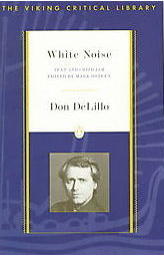DeLillo, Don (1985). White Noise. New York: Viking/Penguin.
“White noise” is a hissing sound, similar to static on a radio or the sound of ocean surf. Don DeLillo’s White Noise takes that phenomenon metaphorically. The noise is the incessant background of advertising and other mass media in everyday life, and the complementary noise of a consumerist society. There is so much information, every message projected with equal intensity, that the result is merely a hissing sound. Modern life is white noise.
That is the central insight and message of this novel of ideas, but there are others. The white noise of life in the consumer culture is punctuated by moments of awareness of mortality, something that is never mentioned in mass media. People “pass away,” but one’s personal mortality? It cannot be mentioned, for it is not a thought that will sell products and services.
Another occasional spike in the smooth white noise of ordinary everydayness is reason. Advertising depends on unreason. If you applied reason to advertising, it would be apparent that the message is nonsense. Instead, the ad tries to emotionally persuade you that you would be a better person if you were more like the ideals portrayed, and the same goes for the news, movies and magazines, in university history courses, and in every form of modern mass communication. Reason must be devalued in a consumerist society.
In the novel, a comfortable middle-class family in an imaginary, isolated, rural town, lives the white noise life. The protagonist, Jack Gladney, is a distinguished professor of Hitler studies at the small College On A Hill. His wife teaches classes in yoga, reading, and “food and drink” for various charitable organizations. Their house is full of four young children from previous marriages. They live a secure, passive, cocoon-like, domestic life, happy with the children, but by no means blissful, for the Gladney adults suffer from paralyzing fear of death.
The Gladneys, and everyone in their town, suffer from the Nietzschean “slave” mentality, meekly following the intellectual agenda set by the master elites. The elites are the people who control the mass media, the advertisers and newscasters, anyone on TV, but also “the system” in general, the unseen people who run the world, the financial people who make money come out of the ATM, the police and emergency responders who suddenly appear to take charge when natural disaster strikes, and even airline pilots who somehow get you to your destination. Those figures, authority figures, bigger than life, are the ones who pull the levers behind the curtain. They represent “the system” that controls and yet protects and sustains ordinary everydayness.
The humor in DeLillo’s satire arises from the characters’ fascination with television, magazines, and brand names, especially with packaged products in the supermarket, a modern-day holy place. “With groceries, we achieve a fullness of being, a plenitude.” Jack desperately tries to learn German before a big Hitler conference, to cover his shame of being a pre-eminent Hitler scholar who does not know German. In the supermarket, an anonymous voice announces over the loudspeaker, “Kleenex, your truck is blocking the entrance.” It’s the reassuring, god-like voice of the system.
Featureless, anonymous consumer life offers insulation from dying because everything is static and predictable. But the cost is meaning. If every product announcement is equally intense, nothing stands out as meaningful. Facts about Elvis Presley’s life are just as meaningful as facts about Hitler’s life. Again, the characters don’t realize all this. The social satire is DeLillo’s joke, not theirs. They play their parts straight, giving DeLillo setup for his deadpan humor.
DeLillo’s writing style is crisp. Every sentence is edited down to its essentials. Sentences in the form of a well-observed list of nouns or features is a technique he uses often. Dialog often borrows the rat-a-tat rhythms of a Beckett or Mamet. Another interesting technique is the insertion of the non-sequitur, often a quote from the TV running in the background.
“Later I sat up in bed in my bathrobe studying German…The TV said: “And other trends that could dramatically upset your portfolio.” Denise came in…”
These non-sequiturs contribute to the sense of all-pervading white noise. Another fascinating technique is the seamless blending of objective narrative description with flashback. “Alfonse sat at the head of the table, a commanding presence even in a campus lunchroom. He was large, sardonic, dark-staring, with scarred brows and a furious beard fringed in gray. It was the very beard I would have grown in 1969 if Janet Savory, my second wife, Heinrich’s mother, hadn’t argued against it. “Let them see that bland expanse,” she said, in her tiny dry voice.”
There are many other innovative and skillful techniques used to make every sentence, every dialog, every scene, about as gripping as it possibly could be. I admire such skilled writing. On the down side, there is no plot, no narrative throughline to speak of. There is a weak, sardonic drama at the end, with a lame, unresolved ending, but basically, this is a slice of life drama. What makes it interesting is that it is neither character- nor plot-driven. Rather it is driven almost solely by the sheer force of DeLillo’s writing.

